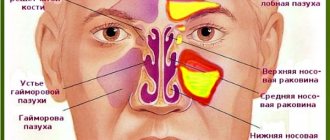Description of the disease
A boil is an inflammatory process of the hair follicle inside the nose. Its manifestation is facilitated by the activation and proliferation of pathogenic microorganisms - staphylococci. Mainly localized on the tip and wings of the nose, septum and nasal passages.
On this topic
- Boil
How to recognize and treat a boil under the armpit
- Irina Nasredinovna Nachoeva
- August 19, 2020
The disease, if not properly treated, can lead to serious consequences.
The main danger of the pathology is the penetration of pus through the bloodstream into the skull and brain.
How does furunculosis develop?
Without treatment, the disease progresses in several stages with ever-increasing relapses. It is quite difficult to get rid of it without appropriate treatment.
First stage (mild)
Once bacteria enter the hair follicle inside the nose or the sebaceous gland, they begin to damage cell membranes and also dissolve hyaluronic acid (this is a kind of “cement” that forms the basis of the tissue). The result is a local reaction of the body. Cells of the immune system rush to the affected area, and fluid begins to accumulate in the affected area (an infiltrate is formed).
At this stage, patients may experience the following symptoms:
- There is pain and scratching in the affected area.
- The number of boils that form is 1-3.
- Possible enlargement of regional lymph nodes.
- Some patients report a feeling of heat in the affected area.
After 3-4 days, the boil itself forms. It is cone-shaped and ends in a white “cap” at the top. After a few more days, the boil opens and purulent contents flow out of the wound.
Second stage (moderate furunculosis)
If no therapeutic procedures are carried out, the disease will return again (up to several times a year). The boils will become larger and their number will increase each time. They may merge to form a carbuncle. Over time, the following manifestations will be added to the symptoms:
- Violent inflammatory reaction.
- Heat.
- General weakness, loss of ability to work.
- Increased sweating.
Such symptoms indicate maximum activity of the human immune system. All protective forces are thrown into the fight against pathogenic microorganisms.
Third stage
At the last stage of the disease, the symptoms will subside. Boils will appear constantly (under the nose, on the mucous membrane, on the wings - their area of distribution will increase significantly), but the swelling before their formation will be practically unnoticeable. The general condition of the patient will be accompanied by weakness, constant fatigue, and the inability to lead a normal active life.
This is due to suppression of the immune system. General intoxication of the body is caused by the activity of bacteria. Toxic compounds secreted by staphylococci or streptococci constantly enter the bloodstream.
Diagnosis of the disease
To determine furunculosis, the doctor must conduct certain types of studies:
- Clinical. Examine the nose, study its inner surface in detail. Collect anamnesis in accordance with patient complaints.
- Laboratory. Take a smear of the contents of the boil to determine the pathogen, and conduct a blood test to rule out sepsis (blood poisoning).
Additionally, the doctor may prescribe tests for sugar to rule out diabetes, check hormonal levels, and check stool for worm eggs. Furunculosis is quite easily identified; difficulties with diagnosing this disease are rare.
to suspect the formation of an abscess in a child who cannot yet express his feelings in words:
- The baby is lethargic, apathetic, something is bothering him.
- The child constantly touches and picks his nose.
- If the boil is located inside, on the mucous membrane, the baby shakes his head and refuses food.
- The child's nose is red or there are small areas of redness that are painful when pressed.
Basic treatment strategies
Depending on the stage of furunculosis and the patient’s condition, three types of treatment are possible:
- Local therapy;
- General therapy;
- Surgical opening of an abscess.
The doctor determines their combination, as well as the preferred drugs, based on the type of causative bacteria.
Local agents
For furunculosis, the following drugs are used:
- Boric alcohol for treating the skin around the boil. It has an antiseptic effect, preventing the spread of infection.
- Ichthyol and balsam ointment (another name is Vishnevsky ointment). The drugs are applied strictly until the boil ripens. They have an antiseptic effect and enhance regenerative processes in tissues.
- Fusidic acid and mupirocin (in ointment form). The drugs contain natural antibiotics that suppress the activity of pathogenic bacteria. The ointment can be applied to boils throughout the entire period of the disease. Mupirocin is a particularly valuable remedy because it is suitable for intranasal use (the ointment is injected directly into the nasal passage).
- Salt solution (1%) . Bandages are moistened with it and applied to the boil and the surrounding area (if the skin is affected on the tip or wings of the nose). The procedure can be performed at any stage of the disease, especially after opening the boil (salt ensures good outflow of fluid with purulent contents).
In some cases, heating may be indicated. Its appropriateness must be determined by a doctor.
General therapy
Additionally, antibiotics are usually prescribed with ointments to suppress pathogenic microflora . They are taken during the period of exacerbation of the disease - the formation and maturation of boils.
Common drugs active against staphylococci and streptococci are prescribed: Vancomycin, Cefazolin, Amoxiclav.
Antibiotics should be prescribed only after the pathogen has been identified. A big advantage would be to determine the sensitivity of bacteria to specific drugs to improve the effectiveness of treatment.
For chronic nasal furunculosis, in the periods between exacerbations, it is recommended to take a course of immunomodulatory drugs: Polyoxidonium. Lycopid. Galavit.
It is also possible to prescribe antihistamines to mitigate the course of the disease and reduce the severity of symptoms. However, in medical practice they are prescribed quite rarely. Before the boil erupts, the patient is often tormented by pain at the site of inflammation; in these cases, it is possible to take analgesics.
Surgical removal of a boil
The indication for surgical intervention is the development of extensive abscess and tissue necrosis . The patient is hospitalized, an incision is made under general or local anesthesia and the drainage of pus is organized. The operation is quick and usually without consequences. Opening marks may remain when the boil is located too close to the vestibule of the nose.
Important! Opening a boil yourself is very dangerous! In the absence of sterile conditions and skills, there is a high risk of pathogenic bacteria entering the bloodstream and the development of sepsis.
Even if the autopsy is performed successfully at home, scars from such an operation are much more likely than with a specialist. The doctor will try to use the natural folds of the skin to make the incision. If the wings or tip of the nose are affected, this will make it possible to preserve its aesthetic appearance.
Furunculosis is a disease that does not pose an immediate threat to the patient’s life, but can be dangerous due to its consequences. It is extremely important, immediately after discovering an abscess, not to try to treat it at home, but to contact a competent specialist and conduct a full examination.
Literature: Otorhinolaryngology. Edited by Karpishchenko S.A.
Short course of otorhinolaryngology. V.T. Palchun, M.M. Magomedov, A.V. Gurov
Practical skills in otorhinolaryngology. G.M. Partenko
Otorhinolaryngologist L.V. Ledova
Causes
The main provocateurs of boil formation are, as a rule, staphylococci. These are the most common bacteria, which are characterized by rapid reproduction, since they can be activated simultaneously in several planes.
Pathological microorganisms are quite resistant to antiseptic drugs and most antibiotics.
Less commonly, boils appear under the influence of streptococci. These are bacteria whose location is the mucous membrane.
They attach to cells using special cilia. Streptococci have a capsule on the outside that protects them from the body's reaction.
In general, these representatives of microflora are a natural phenomenon and are present in the human body throughout life. Numerous factors contribute to their activation.
On this topic
- Boil
Let's find out how to treat a boil on the eye
- Irina Nasredinovna Nachoeva
- August 19, 2020
In addition, penetration of the microbe is possible as a result of even minor trauma to the skin. This may occur under circumstances such as:
- trying to squeeze out a pimple;
- nose picking
- hygiene rules - unclean water is used for washing, the nose is wiped with unwashed hands;
- plucking hairs in the wrong way;
- purulent discharge that does not go away for a long time.
In most cases, active bacterial activity is observed against the background of decreased immunity. A healthy immune system helps to independently neutralize many pathogens. But when protective functions are reduced, this leads to the proliferation of bacteria, which provokes the development of inflammatory processes.
The weakening of human immunity occurs under the influence of a number of reasons. Among them are:
- sinusitis;
- rhinitis;
- sinusitis in acute or chronic form;
- frontal sinusitis;
- hormonal imbalances ;
- disruptions in metabolic processes;
- hypothermia;
- AIDS;
- bacterial or viral infections
- taking glucocorticosteroids for a long period;
- helminthic infestations;
- treatment with cytostatics;
- diabetes ;
- pathologies of the endocrine, respiratory systems or digestive organs.
Only if the root cause that contributed to the manifestation of the disease is correctly identified, treatment will be more effective.
Types of boils in adults
Like any other disease, ulcers inside, on the tip or wing of the nose can have their own varieties. A purulent formation consisting of several ulcers fused together is called a carbuncle. Typically, up to ten pimples form a carbuncle.
Multiple abscesses that appear simultaneously in different parts of the new cavity - on the tip, wings or inside - are called furunculosis.
Furunculosis is the most dangerous manifestation of ulcers. This condition must be treated urgently.
The disease usually occurs in an acute form. But in the absence of proper treatment and neglect of hygienic measures, recurrent boils can occur. This means that the disease has become chronic.
At the location of the abscess, an internal boil or boil on the tip or wings of the nose is isolated.
Based on the stage of the disease, boils inside, on the wings or on the tip of the nose are infiltrative (inside which exudate accumulates), purulent (with the formation of purulent masses) and necrotic (when a necrotic rod with dead cells forms inside the abscess).
Symptoms
As a rule, the formation of a boil in the nose occurs in three stages.
At the initial stage, after the bacterium penetrates the hair follicle of the nasolabial triangle or the duct of the sebaceous gland, damage to the cell membrane is noted, as well as the dissolution of hyaluronic acid, which makes up the tissue base.
There is a rapid flow of immune system cells to the affected area. An infiltrate begins to form in this area.
This stage is accompanied by the following symptoms:
- scratching and pain in the damaged area;
- the number of formed boils reaches up to three;
- enlargement of regional lymph nodes;
- heat in the affected area.
Four days later, the boil itself begins to form. It is characterized by a cone-shaped shape with a white cap at the end. After a few more days, the boil ruptures on its own, and purulent fluid begins to come out of it.
If you do not pay attention to treating the pathology at the initial stage, the disease will often manifest itself. Boils become larger and their number will increase with each new appearance. In some cases they merge to form a carbuncle.
New symptoms are added to the already described symptoms:
- intense inflammatory process;
- increased temperature ;
- excessive sweating;
- general weakness of the body;
- decreased ability to work.
On this topic
- Boil
Details on how to treat a boil on the leg
- Inna Viktorovna Zhikhoreva
- August 17, 2020
These symptoms indicate increased activity of the body's defense reaction in the fight against pathogenic bacteria.
The last stage of the disease is characterized by a decline in accompanying symptoms. However, the appearance of boils will be constant (in the vestibule of the nose, on the bridge of the nose, on the wings), the affected area will increase all the time. In this case, there will be practically no swelling.
At this time the patient will feel:
- weakness;
- constant fatigue;
- restriction of leading a normal active life.
This condition is explained by a decrease in the body’s protective functions. Intoxication is provoked by the active activity of pathogenic microorganisms. The blood constantly receives toxic compounds that are secreted by streptococci or staphylococci.
Symptoms of furunculosis
Attention! During rhinoscopy, the specialist will determine the stage of the nasal boil. Depending on this, treatment tactics will be determined.
The initial stage of the pathology is characterized by significant local swelling of the tissues; their clear delineation is not observed. In advanced cases, a negative focus can be significant
Photo 25 - Rhinoscopy
significant parameters – with the involvement of several hair follicles in the process. In this case we are already talking about a carbuncle.
Photo 26 - Carbuncle
The boil matures gradually - over several days, usually no more than five. The maturation process is accompanied by severe tissue tension, leading to significant pain in them. As the boil opens, the pain gradually subsides and the temperature parameters decrease.
Photo 27 - The boil matures no more than five days
Attention! An increase in the symptoms of general intoxication will indicate the addition of a complication; the most dangerous seems to be meningitis or thrombosis of the sinus of the human brain.
Photo 28 - A boil in the nose is dangerous for the brain
Diagnostics
To make a diagnosis and confirm the presence of a boil in the nose, a number of examinations are necessary. Basic:
- A smear of fluid taken from a boil. Allows you to determine the type of pathogen.
- Blood test to rule out possible infection.
- Visual inspection and careful examination of the inner surface of the nose. Collecting anamnesis based on the patient's complaints.
- Monitoring the state of the nervous system.
On this topic
- Boil
Details on how to remove boils on the neck
- Inna Viktorovna Zhikhoreva
- July 28, 2020
To exclude the possible development of diabetes mellitus, the specialist prescribes additional tests:
- analysis of stool for worm eggs;
- study of hormonal levels.
In addition, furunculosis must be differentiated from such pathological conditions as anthrax, skin tuberculosis, hidradenitis and erythema nodosum.
Causes of boils in adults
The main cause of the disease is the activation of staphylococci and streptococci. These same pathogens cause tonsillitis, chronic tonsillitis and sinusitis. In most adults, these microorganisms are constantly present on the mucous membranes, but diseases do not always develop. For inflammation to occur, predisposing factors must occur:
- injuries and mechanical damage to the nasal cavity, including pulling out hairs from the nasal passages - infection can easily get into the wounds; This category also includes surgical reasons: rhinoplasty, installation of implants, etc.;
- a chronic source of infection in the body - chronic tonsillitis, chronic sinusitis, caries, etc.;
- purulent skin diseases of the nasal cavity;
- reduced immunity: the cause of the appearance of an abscess in adults can be simple hypothermia, lack of vitamins, stress, diabetes, HIV, oncology and other factors that “hit” the body’s own defenses;
- violation of basic hygiene rules (neglecting water procedures, constantly touching the face with dirty hands, squeezing pimples are common causes of chirp);
- unfavorable working conditions, work in hazardous industries with polluted air, constant contact with fuel oil and other fuels and lubricants;
- Hormonal imbalance is a common cause of ulcers in pregnant and adult women during menopause.
Treatment of an external abscess and treatment of a boil inside the nose will be most effective if its cause is correctly identified. Finding out the cause of the disease and prescribing a competent treatment regimen is the profile of an otorhinolaryngologist.
Treatment
Therapeutic measures are selected based on the stage of development of the disease, the general condition of the patient and the type of pathogen.
Among the local drugs used:
- 1% saline Designed for moistening bandages and applying them to the affected area. The procedure is indicated for any degree of pathology.
- Balsamic or Ichthyol ointment. They have an antiseptic effect and promote rapid regenerative processes in tissues. They can only be used until the boil has not yet broken out.
- Boric alcohol. It is used to treat the skin surrounding the boil. It also has antiseptic properties and prevents the infection from spreading further.
On this topic
- Boil
What threatens a boil?
- Olga Aleksandrovna Kalinina
- June 24, 2020
Along with ointments, antibiotics are most often prescribed, which are aimed at inhibiting pathogens. They must be taken in case of acute illness, when boils form and mature.
The most common means:
- Cefazolin;
- Tetracycline;
- Vancomycin.
In the chronic form, during the period of remission, a course of immunomodulatory drugs is prescribed:
- Galavit;
- Polyoxidonium;
- Lycopid.
In some cases, it is possible to take antihistamines, which are aimed at relieving the severity of symptoms and improving the general well-being of the patient.
Surgery is indicated only for extensive abscess and tissue necrosis. The patient requires hospitalization. The operation is performed under local anesthesia.
Its essence lies in cutting the boil and draining the pus from it. This method of therapy does not take much time and usually occurs without complications. Scar formation is possible only if the boil has arisen close to the vestibule of the nose.
Furuncle in the nose: How to treat?
Taking into account the patient’s condition and the stage of furunculosis, the disease can be treated in three ways:
- General treatment;
- Local treatment;
- Surgical opening of the boil.
The doctor must determine their combination, as well as suitable medications, taking into account the type of bacteria.
Local remedies
During furunculosis the following drugs are used:
- Balsamic and ichthyol ointment. The products are applied only until the boil ripens. These drugs enhance regenerative processes in tissues and have an antiseptic effect.
- Boric alcohol is used to treat the skin near the boil. It has an antiseptic effect, preventing the spread of infection.
- 1% saline solution. They are treated with bandages and applied to the boil and its surrounding borders (if the skin on the wings and tip of the nose is infected). This process can be performed at any stage of the disease, especially after opening the boil (salt improves the release of purulent fluid).
- Mupirocin and fusidic acid (in the form of ointment). These products contain natural antibiotics that suppress the activity of pathogenic bacteria. The drugs can be applied to boils throughout the course of the disease. Mupirocin is a particularly valuable drug, as it is suitable for intranasal use (the drug is injected into the nasal passage itself).
Sometimes warming up may be prescribed . Its effectiveness must be determined by a doctor.
General treatment drugs
As a rule, in addition to ointments to suppress pathogenic microflora, antibiotics are prescribed, which are taken during an exacerbation of the disease. Popular drugs that are active against streptococci and staphylococci are prescribed:
- Cefazolin. The antibiotic is used intramuscularly or intravenously. It copes well with a wide range of pathogens, but there are strains of staphylococci that have developed resistance to it.
- Vancomycin. The drug is most active against coccal flora, but is useless during infection with mycobacteria. The drug forms holes in the shell of microorganisms, thereby disrupting the functioning of their genome. The product can be used as an injection or taken orally. The first method is the most effective.
- Tetracycline. The product has a wide range of effects and is suitable for internal and external use (the method is determined by the doctor). Among the disadvantages, one can note many side effects, as well as the possibility of resistance to this drug in some representatives of pathogenic microflora.
- Amoxiclav, as well as its analogues. These drugs additionally contain clavulanic acid, a substance that prevents bacterial enzymes (β-lactomases) from blocking the antibiotic ampicillin.
The use of antibiotics should be carried out only after identifying the pathogen. A great advantage is the determination of the sensitivity of microbacteria to certain drugs.
In the chronic course of the disease during an exacerbation, it is recommended to take a course of immunomodulatory drugs:
- Lycopid. It contains particles of bacterial cell walls. This allows the immune system to develop against these pathogens. The product has low toxicity, side effects are minor and rare.
- Polyoxidonium. The drug activates local immunity, increasing the body's resistance to bacteria.
- Autohemotherapy is an outpatient treatment method; the effectiveness of this method is not recognized by all doctors. It consists of a course of blood injections from the cubital vein.
- Galavit. A product with anti-inflammatory and immunostimulating effects. The drug mobilizes all parts of the immune system, accelerates the restoration of mucous membranes and wound healing.
It is also possible to prescribe antihistamines to reduce the severity of symptoms and mitigate the course of the disease. But in practice they are used very rarely.
Complications
The main danger of a boil in the nose is the close location of the purulent focus to the brain. In most cases, the development of complications is facilitated by injuries when trying to squeeze it out, incorrect therapeutic measures, and the use of a handkerchief to wipe the nose.
When purulent contents enter the blood and spread throughout the body, the likelihood of developing complications such as:
- meningitis;
- lymphadenitis;
- sepsis;
- thrombosis of facial vessels;
- abscess of internal organs and others.
If brain tissue is exposed to an infectious process, a fatal outcome cannot be ruled out.
Treatment at home
If the painful boil is relatively small in size and appeared in the nose quite recently, you can get rid of the characteristic growth with purulent contents using alternative methods. Consult with an otolaryngologist first. If the patient does not have an allergic reaction to the herbal components of the recipes presented below, the following folk remedies prepared at home can serve as an auxiliary treatment for the boil:
- You need to mix onion and aloe juice in equal proportions, then mix the composition and rub it on the inflamed abscess. It is recommended to repeat the procedure in the morning and evening until the boil disappears.
- Mix 20 g of dried calendula leaves with petroleum jelly until a homogeneous mass is formed. The resulting cream is required to regularly lubricate the pathology site in the nose for several days in a row. The course of treatment is 10–14 days.
- Soak gauze with raw potato juice, make a compress and place it on the inflamed boil until the tissue is completely dry. The course of treatment is 7 – 10 procedures.
After consultation with a doctor and with his permission, the patient can be treated at home if the abscess on the nose or inside the nose does not cause serious concern. In this case, the doctor may prescribe ointments, lotions or inhalations using medicinal herbs.
Suitable for inhalation: oak bark (20 g), St. John's wort (15 g) or sage (20 g). Any crushed raw material is poured with a glass of boiling water and boiled over low heat for about 5 minutes. The finished broth is poured into a small bowl, you bend over it and cover your head with a towel. Such therapeutic inhalations are carried out for 5 minutes up to 4 times a day.
When using chamomile infusion, the boil will break out on its own in a few days
You can also prepare healing lotions from medicinal herbs. Pour a tablespoon of crushed dry chamomile into a glass of boiling water and leave until it cools. Moisten a cotton swab in the finished infusion and apply it to the problem area.
For the same purposes, you can use a mixture of plantain, mint and coltsfoot, taken 10 g each. The infusion is prepared in the same way as with chamomile. After using lotions and inhalations, the boil will break out on its own in a few days.
The pus released from the boil can be removed with a dry cotton swab, the boil is then treated with Chlorhexidine, Miramistin or hydrogen peroxide. Levosin or Levomikol ointment is applied to the wound so that bacteria do not enter the sore spot and healing occurs faster.
Tar soap is grated and any liquid honey and flour are added to it to make an elastic dough. A turunda is made from it and inserted into the nostril where there is a boil. It is better to carry out this procedure at night until the abscess breaks through.
Why does the boil love the nose?
Purulent inflammation often forms only in the anterior part (vestibule) of the nasal passages. The boil chooses the vestibule of the nose because there are hairs with follicles there. The abscess can appear inside the nose or right at the tip, and also often affects its wings.
A person’s nose is not covered by clothing, which means it is regularly exposed to negative external factors. And the person himself often creates these factors by picking at it with dirty hands, squeezing out pimples and blackheads on the nose, injuring it. It is in the nose that the main causative agents of furunculosis are located - staphylococci, therefore boils on the vestibule of the nose are considered a very common occurrence.
What you need to know about self-treatment of boils
Antibacterial treatment includes applying fueidic acid and mupirocin ointment to the skin. Some doctors may prescribe other drugs. The following are popular: linezolid, cefazolin and others.
Surgical treatment of boils. Surgery is only necessary if abscess formation has occurred. A large purulent pimple is opened under local special anesthesia or under general anesthesia, which must be administered intravenously.
First, the surgeon must carefully cut the center of the inflamed infiltrate, while the edges of the cavity are expanded using special instruments. A similar operation is performed focusing on the natural folds that exist on the skin. Otherwise, the marks from the operation will be very noticeable.
A furuncle on the nasal vestibule can leave behind a noticeable scar, since the skin here is thin, and the wound remains large after such inflammation. To prevent a scar or scar, after the main treatment, the affected area should be treated with wound-healing medications: Solcoseryl or Actovegin. To speed up skin regeneration, you can use Bepanten or Dexapanthenol ointments.
Self-treatment of boils does not always end successfully. Sometimes after it you have to go to the hospital with serious complications. Therefore, it is better not to try self-medication, especially if you have no experience and the exact cause of furunculosis is not known.
Conservative treatment is effective only if the boil occupies a small area and does not involve neighboring hair follicles in inflammation. Systemic antibiotic therapy is mandatory, using broad-spectrum drugs: cephalosporins, macrolides, semi-synthetic penicillins; when conducting bacteriological tests for the presence of a specific pathogen and its sensitivity to antibacterial agents, the medication is selected individually. The doctor may prescribe medications that stimulate the immune system and contain a complex of vitamins.
The treatment tactics for a boil depend on its causative agent, the condition of the patient’s body and the stage of the disease. Therapy is chosen strictly after the diagnosis is determined.
At the initial stage of the pathology, with normal infiltration, it is enough to locally treat the area of the nose affected by the boil with antiseptics. A 2–3% solution of salicylic alcohol is suitable for this purpose.
Local antibacterial therapy is prescribed, which involves the use of Fusidic acid and Mupirocin ointments. They contain antibiotics that suppress the proliferation of pathogenic microorganisms. The ointment should be applied directly to the mucous membrane and boils.
To relieve inflammation and get rid of pain, drugs from the NSAID group are used, for example, Diclofenac, Brufen.
After the boil has matured, an application with crystalline salicylic sodium is carried out, applied to the center of the inflammatory focus, then fixed with a bandage. This product has a keratolytic effect and promotes rapid rejection of the necrotic core.
The boil is wiped with a disinfectant after self-opening. The pus is removed and a turunda soaked in 10% saline solution is inserted into the nose.
To prevent the development of complications, systemic treatment with antibiotics such as Ciprofloxacin and Cefazolin is prescribed. These drugs are also indicated in the presence of symptoms of intoxication.
| Drugs | Photo | Price |
| Galavit | From 307 rub. | |
| Lycopid | From 290 rub. | |
| Polyoxide | From 684 rub. |
Treatment of furunculosis in modern medicine is carried out by qualified doctors with extensive experience. The treatment algorithm is selected individually after laboratory diagnostic measures. The center is equipped with the latest modern equipment, uses its own developments and world experience in the treatment of any pathologies.
How does a nasal boil develop?
The initial acute stage of the disease is characterized by a feeling of discomfort in the vestibule area. Pain appears, which can be of varying intensity - from not too strong to unbearable. Often the pain intensifies at night. If the boil turns black in the middle, this indicates that the root of the boil has formed. Characteristic symptoms:
- hyperemia of the affected area;
- swelling;
- pain at the site of the lesion;
- pain when pressed;
- increased body temperature (systemic symptom).
A laboratory blood test may reveal toxemia. In the next stage (purulent boil), if measures were taken at the wrong time or the treatment was not adequate, the symptoms become more complicated. Diagnosed:
- thrombus formation in the area of the angular vein (outwardly resembles the appearance of a thickened cord);
- increase in general body temperature to significant values;
- swollen lymph nodes;
- swelling of the eyelids, hyperemia of the mucous membrane of the eye, difficulty moving the eyeballs, pain;
- blurred vision;
- bulging eye.
If you do not receive qualified help, swelling of the optic nerves may occur, which leads to complete or partial paralysis of the eye muscle.
A person can be a carrier of infections and not know it. Under suitable conditions (hypothermia, decreased general protective properties, exacerbation of any chronic pathology of the body, stress, increased physical activity, alcohol abuse), streptococci or staphylococci begin to manifest themselves. The formation of a boil is promoted by:
- failure to comply with personal hygiene rules;
- hazardous production;
- hypothermia or overheating of the body;
- diseases of the gastrointestinal tract;
- unbalanced diet with insufficient amounts of vitamins, minerals, microelements;
- endocrine diseases;
- reduced immunity.
Is there a danger to life, what complications?
Considering all of the above, you might think that there is nothing particularly terrible about internal furunculosis of the nose, since the boil eventually disappears. But in fact, this pathology without treatment can cause serious complications.
The nasolabial area has an active blood supply, so any purulent infections of the nose can quickly spread throughout the body through the bloodstream. The worst thing in this situation is infection of the cranial cavity and brain. Such complications cause deep vein thrombosis and meningoencephalitis, which are often fatal.
Without timely treatment, sepsis may develop. This is extensive damage to the body by bacteria and their waste products (toxins), fraught with heart failure and other serious diseases of internal organs, as well as death. To prevent complications, you need to immediately go to the hospital when you find a boil in your nose and treat it correctly.
When a chiryak appears in the nasolabial triangle on the face, it is always life-threatening. Pus under the skin of the face provokes severe complications. The fact is that in this triangular zone in a person, the veins of the nasal sinuses communicate with the veins of the eye sockets, and if pus from the nose gets into the vein, then it spreads with the blood throughout the brain - the eyes can be damaged and blindness can develop, or the nerves of the face can be affected - then it manifests itself facial paralysis Bacteria entering the brain can lead to meningitis. Therefore, when a boil appears, you should not delay a visit to the doctor.
Traditional methods of treatment
Chiryak can be treated at home only after consulting a specialist. What methods can you use:
- Raw potatoes. It is necessary to grate it, soak the juice through gauze and apply to the affected area. Do this procedure 2-3 times a day.
- Onion. Squeeze out the juice and apply 4-5 times a day. The juice must be freshly squeezed.
- Aloe. You will need aloe juice, which can be used to lubricate the boil as often as possible. This method is effective, since aloe is an excellent antiseptic that copes with various purulent inflammations.
- Tea tree oil is a natural antibacterial agent that combats boils.
- Ointment based on beeswax and butter. First the honey is extracted, then the butter is melted. Mix and heat in a water bath. Use as a compress.
Deviated nasal septum: main symptoms and treatment methods
The traditional method of treatment can cope with the initial stage. In case of a complicated form, you must contact a specialist directly.
Boil on the nose
If a person has a regular boil on his nose, then this is not a boil. Since this diagnosis means inflammation of the hair follicle, and there are no hair follicles deep in the nasal cavity or at its tip, therefore the diagnosis of “boil on the tip of the nose” is incorrect. [ads-pc-1][ads-mob-1] Inflammation of the tip of the nose is most often associated with blockage and infection in the sebaceous glands. This process is also called blackheads, pimples or acne.
How to get rid of this process? Surgical removal is practically not used, only in cases of widespread purulent process.
Conservative methods are used: creams, lotions, ointments that relieve inflammation and reduce sebum production. Normalize metabolism, rearrange nutrition and lifestyle. For severe acne, hormones and systemic antibiotics are prescribed.







